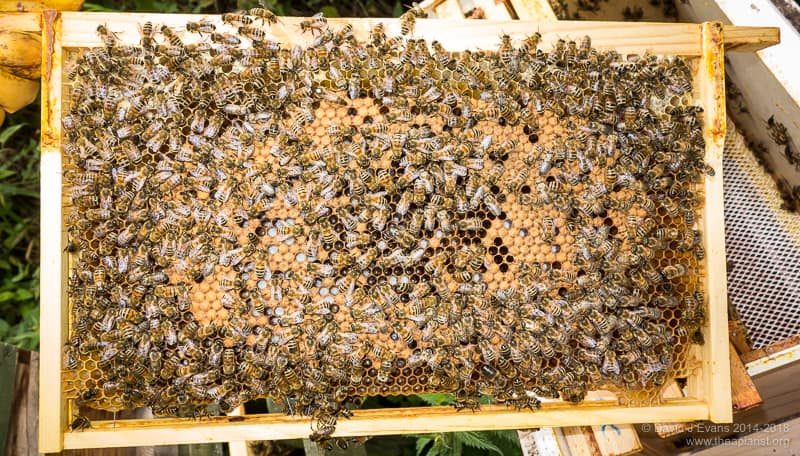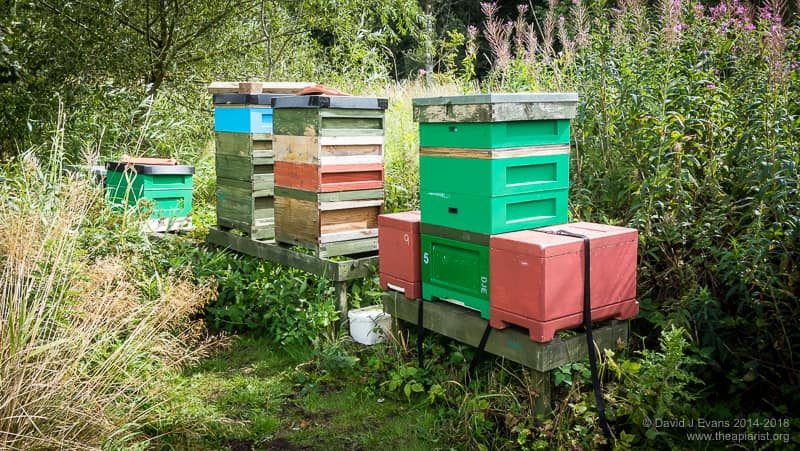They think it's all over!
We’re gently but inexorably segueing into early autumn after an excellent beekeeping season. The rosebay willow herb is almost over, the farmers are busy taking in the harvest and colonies are – or should be – crowded with under-occupied workers.
Drones are being ejected, wasps are persistently looking for access and there’s a long winter – or at least non-beekeeping period – ahead.
There’s a poignancy now in being in the apiary conducting the last few inspections of the season. Only a few short weeks ago, during late May and early June, the apiary was a scene of frenetic productivity … or complete turmoil, depending upon your level of organisation or competence.
Now there’s little activity as there’s not much forage available.
Colonies are busy doing nothing.
The most important time of the season
But that doesn’t mean that there’s nothing to do.
Rather, I’d argue that late August and early September is probably the most important period during the beekeeping year.
However well or badly the season progressed, this is the time that colonies have to be prepared for the coming winter. With good preparation, colonies will come through the winter well. They’ll build up strongly in spring and be ready to exploit the early season nectar flows.
In Fife, this is about 8 months away 🙁
This explains the poignancy.
There are some colonies inspected last weekend that probably won’t get properly opened again until mid/late April 2019. Queens I saw for the first time in August won’t get marked or clipped until next spring {{1}}.
Au revoir!
To survive the winter and build up well in the spring the colony has few requirements. But they are important. A lack of attention now can result in the loss of the colony later.
To appreciate their needs it’s important to understand what the colony does during the winter.
Suspended animation
Honey bees don’t hibernate in winter. In cold weather (under ~7°C) they cluster tightly to conserve energy and protect the queen and any brood in the colony.
At higher temperatures the cluster breaks but they largely remain within the hive. After all, there’s little or no forage available, so they use their honey and pollen stores.
The fat-bodied overwintering bees that are reared in autumn have a very different physiology to the ephemeral summer workers. The latter have a life-expectancy of 5-6 weeks whereas overwintering bees can live for many months {{2}}.
But they’re not immortal.
Throughout the winter there’s a slow and steady attrition of these workers. As they die off the clustered colony gradually reduces in volume, shrinking from the size of a medicine ball, to a football, to a grapefruit … you get the picture.
Some brood rearing does occur. The queen often stops laying after the summer nectar flows stop {{3}} and laying might be sporadic through the autumn, dependent upon weather and forage availability.
However, by the turn of the year she starts laying again. At a much reduced level to her maximum rate, but laying nevertheless and, with sufficient workers in the colony and as forage become available, this rate will increase.
The amount of brood reared during the winter period (late autumn to early spring) isn’t enough to make up for the losses that occur through attrition. This explains why colonies are much smaller in the spring than the early autumn.
Strong, healthy, well-provisioned and weathertight
Knowing what’s happening in the colony during the winter makes the requirements that must be met understandable.
- Strong colonies start the winter with ample bees. Assuming the same attrition rate, a larger colony will get through the winter stronger than a smaller one. There will be more workers available to ‘reach’ stores (I’ll deal with this in the next week or two) and keep the queen and brood warm. Hence there will be more foragers to exploit the early crocus, snowdrop and willow.
- Healthy colonies will have a lower attrition rate. The overwintering workers will live longer. High levels of deformed wing virus (DWV) are known to shorten the life of winter bees. To minimise the levels of DWV you must reduce the levels of Varroa in the colony. Critically, you must protect the overwintering bees from Varroa exposure. Treat too late in the season and they will already be heavily infected …
- Well-provisioned colonies have more than enough stores to survive the winter. The clustered colony will have to move relatively short distances to access the stores. As a beekeeper, you won’t have to constantly meddle with the colony, lifting the lid and crownboard to add additional stores in midwinter.
- Weathertight colonies will be protected from draughts and damp {{4}}.The hive must be weathertight and, preferably, not situated in a frost pocket or damp location {{5}}.
Winter preparation
Once the honey supers are off all activities in the apiary are focused on ensuring that these four requirements for successful overwintering are achieved in a timely manner.
Weak colonies are united with strong colonies. At this stage in the season – other than disease – the main reason a colony is likely to be weak is because the queen isn’t up to the job. If she’s not now, what chance has the colony got over the winter or early spring? {{6}}
Varroa treatment is started as early as reasonably possible with the intention of protecting the overwintering bees from the ravages of DWV. This means now, not early October. Use an appropriate treatment and use it correctly. Apiguard, oxalic acid (Api-Bioxal), Apivar etc. … all have been discussed extensively here previously. All are equivalently effective if used correctly.
All colonies get at least one block (12.5kg) of bakers fondant, opened like a book and slapped (gently!) on the tops of the frames. An eke or an empty super provides the ‘headspace’ for the fondant block. All of the Varroa treatments listed above are compatible with this type of feeding simultaneously {{7}}.
Hopefully, hives are already weathertight and secure. Other than strapping them to the hive stands to survive winter gales there’s little to do.
They think it’s all over!?
It is … almost 🙂
Colophon
They think it’s all over! is a quote by Kenneth Wolstenholme made in the closing stages of the 1966 World Cup final. Some fans had spilled onto the pitch just before Geoff Hurst scored the the last goal of the match (England beat West Germany 4-2 after extra time), which Wolstenholme announced with “It is now, it’s four!”. This was the only World Cup final England have reached, whereas Germany have won four.
As Gary Lineker says “Football is a simple game; 22 men chase a ball for 90 minutes and at the end, the Germans win.”
{{1}}: I tend not to mark and clip queens late in the season. Firstly, the hives are busy and, although the risk of damaging a queen is small, I don’t want to do anything to jeopardise the survival of the colony. Anyway, it’s easier to find her in the spring with fewer workers in the hive.
{{2}}: Under experimental conditions they have been shown to live for at least 9 months.
{{3}}: Almost all of my full colonies are nearly devoid of open brood at the moment … in contrast, recently established nucleus colonies – which ‘know’ they need to build up – are packed with open and sealed brood.
{{4}}: And woodpeckers. Admittedly, not specifically weather-related, though they can result in the weather getting in.
{{5}}: This does not mean that the hive needs to be heated or swathed in huge amounts of insulation. Full colonies here overwinter perfectly well in polystyrene or cedar hives with open mesh floors and a 5cm thick block of Kingspan insulation over the crownboard. The insulation is usually an integral part of the crownboard and is present all year. With an open mesh floor below and insulation above there should be no problems with condensation … and, whatever you might read elsewhere, you should not have matchsticks under the edge of the crownboard.
{{6}}: There are exceptions to this … a very recently mated queen for example. You need to use your judgement. Some beekeepers may be more ‘generous’ than others when making this decision. I often give them the benefit of the doubt, but regret doing so when the colony remains weak the following spring. Better you sacrifice a queen of dubious quality now – and unite the remaining bees with another hive – than probably condemn the entire colony to a slow demise.
{{7}}: Yes … including Apiguard.




Join the discussion ...